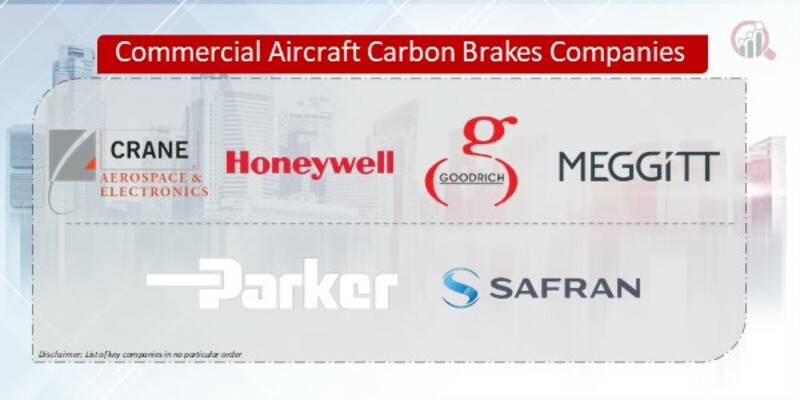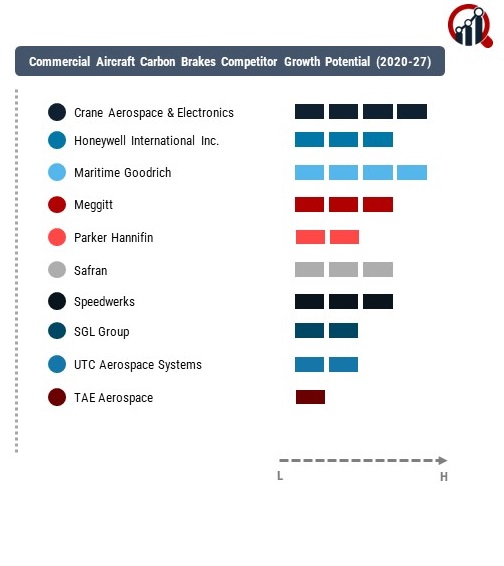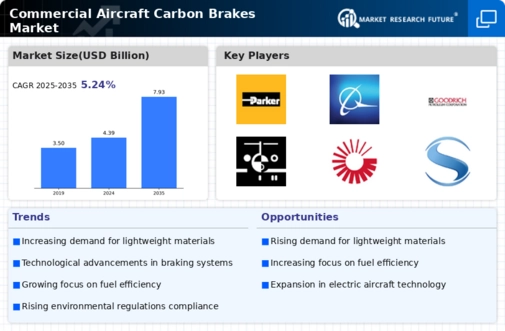Top Industry Leaders in the Commercial Aircraft Carbon Brakes Market

The Commercial Aircraft Carbon Brakes market is a critical component within the aviation industry, playing a pivotal role in ensuring the safety and efficiency of commercial flights. The competitive landscape of this market is shaped by key players, strategies, market share factors, emerging companies, industry news, and current investment trends. Let's delve into each aspect to gain a comprehensive understanding of the dynamic nature of the Commercial Aircraft Carbon Brakes market.
Key Players and Market Dominance:
Crane Aerospace & Electronics (US)
Honeywell International Inc. (US)
Maritime Goodrich (US)
Meggitt (UK)
Parker Hannifin (US)
Safran (France)
Speedwerks (US)
SGL Group (Germany)
TAE Aerospace
and UTC Aerospace Systems (US).
Strategies Adopted by Key Players:
To maintain their competitive edge, key players in the Commercial Aircraft Carbon Brakes market are adopting various strategies. These include continuous research and development to enhance product performance, strategic collaborations with aircraft manufacturers, and a focus on sustainability by developing eco-friendly materials. Diversification of product portfolios to cater to different aircraft models and expanding their global reach through strategic partnerships are also common strategies employed by these market leaders.
Factors for Market Share Analysis:
Market share analysis in the Commercial Aircraft Carbon Brakes sector is influenced by several factors. Technological innovation and the ability to provide lightweight yet durable solutions are crucial determinants. Additionally, compliance with stringent aviation regulations and certifications enhances a company's reputation and market share. Cost-effectiveness, efficient supply chain management, and after-sales services also play pivotal roles in establishing a competitive position within the market.
New and Emerging Companies:
While established players dominate the market, new and emerging companies are making noteworthy strides. These companies often bring innovative solutions and fresh perspectives to the industry. Companies like Beringer Aero, Crane Aerospace & Electronics, and GKN Aerospace are gaining traction with their focus on niche markets, disruptive technologies, or unique value propositions. The entry of these players injects dynamism into the market, challenging established norms and fostering healthy competition.
Industry News and Innovations:
The Commercial Aircraft Carbon Brakes market is highly responsive to technological advancements and industry news. Continuous innovation in materials and manufacturing processes, coupled with breakthroughs in predictive maintenance technologies, are reshaping the landscape. For instance, the development of self-monitoring brake systems and integration with aircraft health monitoring systems has garnered attention, promising increased safety and reduced maintenance costs. Regular updates on such innovations significantly impact market dynamics, influencing the strategies of both existing players and new entrants.
Current Company Investment Trends:
Investment trends in the Commercial Aircraft Carbon Brakes market reflect the industry's trajectory. Major players are investing heavily in research and development, aiming to stay ahead in terms of technology and product performance. Additionally, strategic acquisitions and mergers are prevalent, enabling companies to expand their product portfolios and market reach. Investments in sustainable practices and the development of carbon-neutral technologies also align with the global shift towards environmentally friendly aviation solutions.
Overall Competitive Scenario:
The competitive scenario in the Commercial Aircraft Carbon Brakes market is a delicate balance between innovation, market presence, and strategic alliances. Established players guard their positions by consistently delivering reliable products and staying ahead in terms of technological advancements. New entrants disrupt the status quo by introducing novel solutions and challenging traditional practices. The market's dynamism is further fueled by industry-wide collaborations, as companies seek synergies to address evolving challenges and capitalize on emerging opportunities.
Recent News :
UTC Aerospace Systems have long been at the forefront, leveraging their experience and technological advancements to maintain a significant market share. These companies have established themselves as go-to suppliers for major aircraft manufacturers, contributing to their stronghold in the market.










